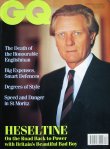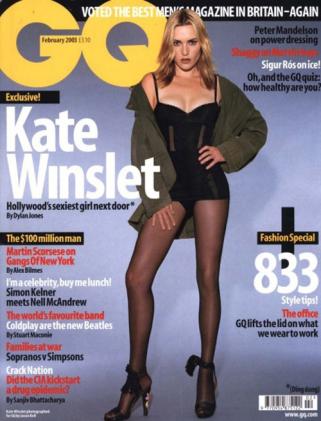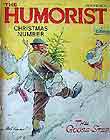Men's magazines: an A to Z
 Men's lifestyle and fashion magazines, lad's magazines, glamour magazines, pin-up magazines
and top-shelf magazines covered alphabetically. This page addresses The
Gentleman's Magazine – regarded as the first modern magazine – to The
Humorist, via GQ and Girl Illustrated. On other pages:
Men's lifestyle and fashion magazines, lad's magazines, glamour magazines, pin-up magazines
and top-shelf magazines covered alphabetically. This page addresses The
Gentleman's Magazine – regarded as the first modern magazine – to The
Humorist, via GQ and Girl Illustrated. On other pages:
Introduction
- 3D titles to Boys Toys
- Carnival to Cut
- Deluxe to Esquire
- Fable to Front
- The Gentleman's Magazine to The Humorist (this page)
- Ice to London Opinion
- Man to Maxim
- Mayfair to Monkey
- Nine to Playboy
- Razzle to Stuff
- T3 to Zoo Weekly
The Gentleman's Journal of MotteuxJan 1692 – 1694Although it only lasted two years, Peter Motteux's Gentleman's Journal, or the Monthly Miscellany, was very influential. In a letter in the review section discussing the earliest newspapers, The Gentleman's Magazine (vol 167, Jan 1840, pp66-7) itself acknowledges the debt it owed to Motteux's innovation:
|
 The Gentleman's Magazine is often considered the first modern magazine |
The Gentleman's Magazine1731-1914Often considered the first modern magazine. The Gentleman's Magazine, or Trader's Monthly Intelligencer, was published by Edward Cave in England in 1731 under the name 'Sylvanus Urban'. It aimed to entertain, with essays, stories, poems and political comment. In 1755, Samuel Johnson's Dictionary credited Cave as coining the term 'magazine' (which had previously meant a storehouse or arsenal) in its publishing sense: 'Of late this word has signified a miscellaneous pamphlet, from a periodical miscellany named the Gentleman's Magazine, by Edward Cave.' The Gentleman's Magazine was
published until the advent of the Great War. St John's Gate in London's Clerkenwell district, is where the magaxzine was published. Today it is the museum of the Order of St John and there is a copy of a bound volume on display in an alcove, along with literary medallions designed by Ronald Searle. |
 Actress Jayne Mansfield on the cover of Girl Illustrated issue 6  Girl Illustrated in its third volume. It is unusual to see the logo in the top right of the cover |
Girl Illustrated [closed]Health & Efficiency Publishing, 1966-1977Large format glamour magazine spun off from naturist magazine Health & Efficiency. Girl Illustrated carried many pins-up in colour. The Girl Illustrated issue showing Katy Manning – who played Jo Grant in Dr Who – wrapped around a Dalek in nothing but a pair of boots, is highly sought-after, fetching up to £120 on eBay. See ‘Katy Manning, a Dalek and a cup of cold sick' |
 First issue of GQ in Germany with a fold-out cover |
GQ (Germany)Deutsch GQ mit Männer-Vogue. Condé Nast Verlag GmbH, Munich. November 1997- |
 June 2006 issue of GQ with a fold-out cover |
GQ (US)Condé Nast, December/Jan 1989-Gentlemen's Quarterly began as a magazine for men's outfitters in about 1927. It then became a fashion supplement to Esquire, in 1957. Gentlemen's Quarterly was sold to Conde Nast by Esquire Inc in 1979. Under Art Cooper's editorship from 1983 (he died in June 2003), it grew to outsell its parent with monthly sales of 700,000 and advertising revenue of $40m. Gentlemen's Quarterly itself grew out of Apparel Arts, a fashion quarterly for men. The core content is fashion and style though it has been forced to adopt pin-up style covers to keep up sales under the onslaught from Maxim and FHM. A 2003 book review (Greenback: The almighty dollar by Jason Goodwin) in the Financial Times said that 'E pluribus unum, the Latin motto on the Great Seal of the US [was] taken from the title page of a magazine that eventually became GQ'. |
 First issue of GQ under editor Paul Keers  Alexandra Shulman, GQ's second editor, vying for the title of most boring magazine cover in April 1991  March 1999 'Sex and violence' issue under Loaded founder James Brown. He got the sacn April 1991  March 1999 'Sex and violence' issue under Loaded founder James Brown. He got the sack after 18 months, supposedly for featuring German WWII general Erwin Rommel in a piece on stylish men  The October 2001 'Men of the Year' issue. Kylie Monogue was one of four covers. It was published in an experimental 'handbag'-sized format. The cover was a double gatefold – with Bono and Benitio del Toro on the other two editorial sides (Polo Ralph Lauren adverts were on the backs)  GQ caused a furore when it 'stretched' Kate Winslet to look tall and thin on a 2003 cover |
GQ (UK)Condé Nast, December/Jan 1989-In the UK, GQ started out under editor Paul Keers with a straight interpretation of the US magazine's original name: Gentleman's Quarterly. Keers had formerly worked on Cosmo Man. His cover 'babe' was Conservative politician (and founder of publisher Haymarket) Michael Heseltine. (There was a certain irony here, given Heseltine's failed attempt to address the men's market almost 30 years earlier.) The first issue sold 90,000 copies, suggesting a settle-down figure of about 63,000. The company's target was 50,000. Most of Arena's readers were under 30, with GQ aiming for men in their mid- to late-thirties with enough money to attract top-quality advertisers. Stephen Quinn, GQ's publisher, identified economic and political factors in making the launch possible: 'There are indications that the time and mood is right. Mrs Thatcher seems to have re-invented this enterprise culture in Britain that has led to a growth of business success which has required more professional men to service it.' The target readers would have more disposable cash to spend after the recent lowering of the top rate of income tax. Interestingly, Quinn had moved from National Magazine to Condé Nast in 1987 after a rumoured launch of Esquire in the UK had fallen through.The Financial Times reported that US GQ had 'had a little problem around 1980 when it flirted with the gay market, but a new publisher soon put a stop to that'. So Keers and Quinn went for a resolutely macho image. Getting it right was tricky, however. Keers argued that being super-macho wouldn't dissuade anyone from sampling the first issue but later felt that it was 'over masculine' with features on boxing, dog fighting and the Cresta Run. Although he added: 'It would have concerned us a great deal more if we'd been too effeminate.' Along with the fashion coverage, he was looking for gritty issues, such as testicular cancer and innocent men being accused of rape. As well as having to avoid a gay stereotype, the men's titles had to avoid being seen as what had been up to then 'men's magazines' – the pornographic titles. So both Arena and GQ continued with men on the cover, including actors John Hurt and Terence Stamp, and high-achievers such as broadcaster John Birt, musician Peter Gabriel and writer Martin Amis. By issue seven, GQ had its second editor, Alexandra Shulman. It continued an all-male cover policy and cover lines had become more aggressive: a full-face image of Sean Connery was graced with the cover line 'Are you hard enough' (February 1991). Yet, a couple of months later, it ran what was probably the most boring men's magazine cover of all time – of Tory prime minister John Major (April 1991).Under its third editor, American Michael VerMeulen, GQ, by now fighting with Arena to be the 'male fashion bible', found excuses to smuggle women on to its covers: February 1993 saw French actress Juliette Binoche in a clinch with Jeremy Irons, both stars of the film Damage. 'Sex, love and obsession' was the cover line. Then, January 1994 saw the results of a reader survey used as the excuse for a bikini-clad woman on the cover. However, March 1999 saw a line drawn in the sand at GQ. Editor James Brown (ex-Loaded) was sacked after 18 months, despite a 12% rise in sales, supposedly for featuring Rommel in a piece on stylish men. The cover theme was 'Sex and Violence: Special issue on men's twin obsessions with 24 pages of erotica'. The model Caprice was photographed for the cover with airbrushed nipple and wearing nothing but slingbacks and diamond-encrusted handcuffs. The Guardian quoted a Condé Nast source: 'We wanted GQ to be a mixture of good writing with a bit of sex... Unfortunately, we had a little too much of the latter and not enough of the former. It was too downmarket; this was the final straw.' Managing director Nicholas Coleridge said: 'James brought energy and humour to the editorial mix. Unfortunately philosophical differences have arisen.' Condé Nast profile |
GQ ActiveCondé Nast, 2004?Men's magazine publishers have tried to break into the health sub-segment, mainly with spin-offs: GQ Active, FHM Bionic and ESQ (Esquire Sports Quarterly). These met with limited success against Men's Health. Condé Nast profile |
 GQ Style: twice yearly fashion magazine for men |
GQ StyleCondé Nast, September 2005-Twice-yearly fashion magazine for men launched against Arena Homme Plus (Emap). GQ Style features covered grooming, fashion, interiors, art, media and travel. The initial print run was set at 100,000 with 20,000 of these copies distributed through controlled circulation. David Bradshaw, former creative director at Prada, was creative director for the magazine. Condé Nast profile |
 Guts: 'Playful, masculine, schoolboy, sexy' for young French men
|
GutsSCPE (Hachette Filipacchi), 30 March 2006-Gérard Ponson (publisher of men's magazines Maximal, a licensed version of Maxim since 2000, Choc and Entrevue) and Hachette Filipacchi Medias launched fortnightly men’s entertainment magazine, Guts. The formula looks similar to IPC's Nuts, with schoolboy humour, cars, shopping, TV listings and sports news on the menu. Sébastien Cauet, a TV and radio presenter, fronted the magazine. The editorial approach was summarised as: 'Ludique, masculin, potache, sexy.' ('Playful, masculine, schoolboy, sexy.') Guts has a target circulation of 300,000 from a launch budget of €5m. TV advertising featured Carmen Electra and Victoria Silvstedt. The target market was men aged 15-35. |
 Harpers & Queen Men – one-off edited by Paul Smith |
Harpers & Queen MenCondé Nast, one-off, November 2000To celebrate its 30th birthday, H&Q published its first men's supplement, Harpers & Queen Men at 48 pages. It was edited by fashion designer and retailer Paul Smith and had Brian Ferry at the races with his Aston Martin on the cover. It was never launched as a standalone men's magazine. Condé Nast profile |
 The Hit in October 1985. It was a music and lifestyle weekly
for 15-19-year-old men that was 'Harder than the rest' |
The Hit [closed]PC/Holborn Publishing Group, September 1985Editor Phil McNeill set out to produce a music and lifestyle weekly for 15-19-year-old men that was 'Harder than the rest', such as The Face. The first issue of The Hit included a free four-track vinyl EP with track by: Style Council, Jesus and Mary Chain, Redskins and Simply Red. Sales of 180,000 were predicted for The Hit, but the first issue reached just 100,000, a total that fell to 80,000 by the sixth issue and the title was withdrawn. The Hit was reported as having cost £1m and needing another £1m and a year of losses to break even, an investment IPC was unwilling to make. Emap was also investigating the men's market but rather
than a general interest magazine launched music title Q for men
aged 18-30. |
 The Humorist: Christmas 1939 |
The Humorist [closed]Printed by Newnes & Pearson Printing, Exmoor St, Ladbroke Grove W10 and published by George Newnes 8-11 Southampton St, Strand, London. 1922?-1940The Humorist was a large-format weekly magazine on newsprint based around cartoons with humorous stories and jokes. A typical issue was 24 pages for 2d. It was similar in format to London Opinion (it was controlled by the same publishing company) and was taken over by that title in 1940. Cartoonists it published included Bert Thomas, Harry Rountree, Alfred Leete ('Your country needs you'), Will Owen, W.L. Ridgewell, Wallis Mills, D.L. Chilchik, Treyer Evans (who did covers in the 1930s and later illustrated Enid Blyton book jackets) and Bertram Prance. Writers included Maurice Lane-Norcott, K.R.G. Browne, Richmal Crompton and J. Jefferson Farjeon. W. Heath Robinson did a series of full-page illustrations of 'some new ball games' with examples such as 'foot golf' and 'squash polo'. The 23 August 1930 issue carried a cut-out coupon on the inside front cover for 'Free gifts for everybody'. Readers could collect points coupons from George Newnes weeklies (Humorist, Tit-Bits, Woman’s Life, Lady’s Companion, London Opinion) and monthlies (Happy Mag, Sunny Mag, The Grand Magazine) to exchange for 'useful free gifts of quality and distinction'. The Humorist: cover masthead from 1930 |



